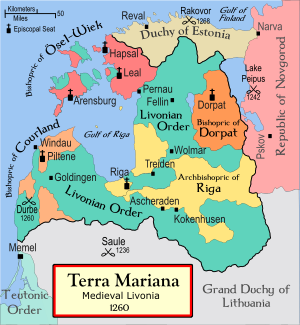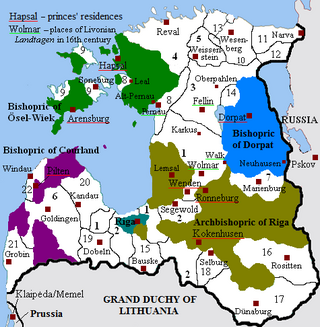
Livonia or in earlier records Livland, is a historical region on the eastern shores of the Baltic Sea. It is named after the Livonians, who lived on the shores of present-day Latvia.
The Northern Crusades or Baltic Crusades were Christian colonization and Christianization campaigns undertaken by Catholic Christian military orders and kingdoms, primarily against the pagan Baltic, Finnic and West Slavic peoples around the southern and eastern shores of the Baltic Sea, and also against Orthodox Christian Slavs.
The Livonian Brothers of the Sword was a Catholic military order established in 1202 during the Livonian Crusade by Albert, the third bishop of Riga. Pope Innocent III sanctioned the establishment in 1204 for the second time. The membership of the crusading order comprised warrior monks, mostly from northern Germany, who fought Baltic and Finnic polytheists in the area of modern-day Estonia, Latvia and Lithuania. Alternative names of the Order include Christ Knights, Swordbrothers, Sword Brethren, Order of the Brothers of the Sword, and The Militia of Christ of Livonia. The seal reads: +MAGISTRI ETFRM MILICIE CRI (Christi) DE LIVONIA.

The Grand Duchy of Lithuania was a European state that existed from the 13th century to the late 18th century, when the territory was partitioned in 1795 among the Russian Empire, the Kingdom of Prussia, and the Habsburg Empire of Austria. The state was founded by Lithuanians, who were at the time a polytheistic nation born from several united Baltic tribes from Aukštaitija.

Semigallians were the Baltic tribe that lived in the south central part of contemporary Latvia and northern Lithuania. They are noted for their long resistance (1219–1290) against the German crusaders and Teutonic Knights during the Northern Crusades. Semigallians had close linguistic and cultural ties with Samogitians.
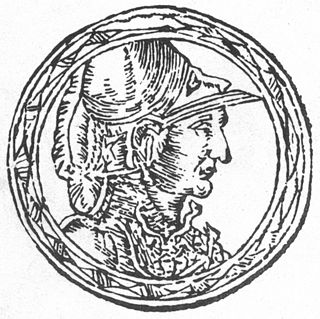
Traidenis was Grand Duke of Lithuania from 1269 or 1270 until 1282. He is the second most prominent grand duke of Lithuania in the 13th century after Mindaugas. His reign ended a seven-year unrest period after Mindaugas was assassinated in 1263 and firmly established the Grand Duchy as a pagan state for another hundred years.
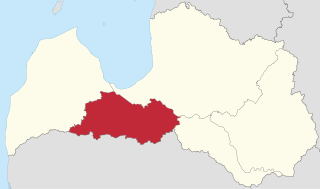
Semigallia, also spelt Semigalia, is one of the Historical Latvian Lands located to the south of the Daugava river and to the north of the Saule region of Samogitia. The territory split between Latvia and Lithuania, previously inhabited by the Semigallian Baltic tribe. They are noted for their long resistance (1219–1290) against the German crusaders and Teutonic Knights during the Northern Crusades. Semigallians had close linguistic and cultural ties with Samogitians.
The Battle of Skuodas or Schoden was a medieval battle fought in ca. 1259 near Skuodas in present-day Lithuania during the Lithuanian Crusade. The Samogitian army of 3,000 invaded Courland and on their way back defeated the Livonian Order, killing 33 knights and many more low-rank soldiers. In terms of knights killed, it was the eighth largest defeat of the Livonian Order in the 13th century. This victory led to a Semigallian insurrection against the Livonian crusaders, which lasted from 1259 to 1272.

The Battle of Durbe was a medieval battle fought near Durbe, 23 km (14 mi) east of Liepāja, in present-day Latvia during the Livonian Crusade. On 13 July 1260, the Samogitians soundly defeated the joint forces of the Teutonic Knights from Prussia and the Livonian Order from Livonia. Some 150 knights were killed, including Livonian master Burkhard von Hornhausen and Prussian land marshal Heinrich Botel. It was by far the largest defeat of the knights in the 13th century: in the second-largest, the Battle of Aizkraukle, 71 knights were killed. The battle inspired the Great Prussian Uprising and the rebellions of the Semigallians, the Couronians, and the Oeselians. The battle undid two decades of Livonian conquests and it took some thirty years for the Livonian Order to restore its control.

The Livonian crusade consists of the various military Christianisation campaigns in medieval Livonia – modern Latvia and Estonia – during the Papal-sanctioned Northern Crusades in the 12–13th century. The Livonian crusade was conducted mostly by the Holy Roman Empire and the Kingdom of Denmark. It ended with the creation of Terra Mariana and the Danish duchy of Estonia. The lands on the eastern shores of the Baltic Sea were one of the last parts of Europe to be Christianised.
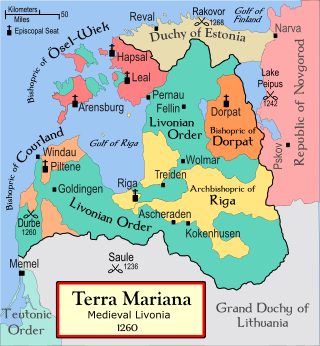
The Battle of Karuse or Battle on the Ice was fought on 16 February 1270 between the Grand Duchy of Lithuania and the Livonian Order on the frozen Baltic Sea between the island of Muhu and the mainland. The Lithuanians achieved a decisive victory. The battle, named after the village of Karuse, was the fifth-largest defeat of the Livonian or Teutonic Orders in the 13th century. Almost all that is known about the battle comes from the Livonian Rhymed Chronicle, which devoted 192 lines to the battle.
Nalšia or Nalšėnai was an ancient land in the early stages of the Grand Duchy of Lithuania. It is mentioned in written sources from 1229 to 1298. The references to it cease as it was fully incorporated into the Grand Duchy. While it is known that it was on the north-eastern border of Lithuania proper, the exact location is unknown and is debated among historians. It is believed that Nalšia was between Livonia and the Duchy of Lithuania and bordered Deltuva. Towns of Švenčionys and Utena are often identified as the most prominent settlements in the land. Several dukes of Nalšia are known. The most prominent of them was Daumantas of Pskov. Others were Lengvenis, nephew of Mindaugas, Suksė (Suxe), who defected to the Teutonic Knights, and Gerdenis, rival to Daumantas.
Duchy of Trakai was a subdivision of the Grand Duchy of Lithuania during the 14th and early 15th centuries. The Duke of Trakai was an important position held either by the Grand Duke of Lithuania himself or his second-in-command.

Dinaburga Castle, also known as Vecdaugavpils or Vecpils, is a castle located in Naujene Parish, Augšdaugava Municipality in the Latgale region of Latvia, east of Daugavpils. It is strategically situated on a high bank of the Daugava River. It was built between 1273 and 1277 by the Livonian Order, and destroyed by Russian troops before 1577. Nowadays, fragments of the foundation are exposed.
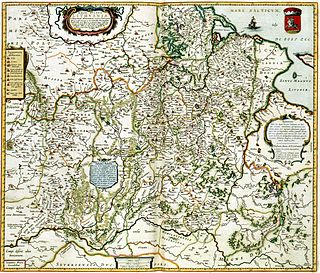
The history of Lithuania between 1219 and 1295 concerns the establishment and early history of the first Lithuanian state, the Grand Duchy of Lithuania. The beginning of the 13th century marks the end of the prehistory of Lithuania. From this point on the history of Lithuania is recorded in chronicles, treaties, and other written documents. In 1219, 21 Lithuanian dukes signed a peace treaty with Galicia–Volhynia. This event is widely accepted as the first proof that the Baltic tribes were uniting and consolidating. Despite continuous warfare with two Christian orders, the Livonian Order and the Teutonic Knights, the Grand Duchy of Lithuania was established and gained some control over the lands of Black Ruthenia, Polatsk, Minsk, and other territories east of modern-day Lithuania that had become weak and vulnerable after the collapse of Kievan Rus'.
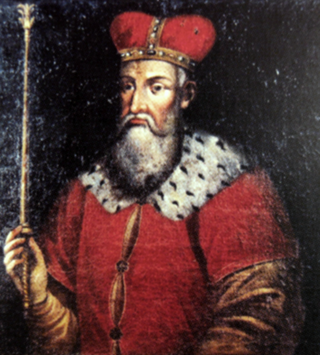
Vytenis was the Grand Duke of Lithuania from c. 1295 to c. 1316. He became the first of the Gediminid dynasty to rule for a considerable amount of time. In the early 14th century his reputation outshone that of Gediminas, who is regarded by modern historians as one of the greatest Lithuanian rulers. The rule of Vytenis was marked by constant warfare in an effort to consolidate the Grand Duchy of Lithuania with the Ruthenians, Masovians, and the Teutonic Order.
The Battle of Medininkai took place on 27 July 1320 between the Teutonic Order and the Samogitian army near Medininkai.
The Battle of Memel was fought between the Samogitians and the Livonian Order in 1257 near Memel.
Nameisis or Namejs was a Semigallian duke in the second half of the 13th century. He ruled in the western part of Semigallia, with his capital at Tērvete. In 1279–81, he led a Semigallian uprising against the Livonian Order, a crusading military order. Very little is known about his life. He is mentioned only in the Livonian Rhymed Chronicle and in some documents from the 14th century. For this reason he is sometimes referred as semi legendary ruler in Latvian historiography.

Gediminas' Cap was the most important regalia of the Lithuanian monarchs who ruled the Grand Duchy of Lithuania until the Union of Lublin in 1569. During the inaugurations of Lithuanian monarchs, Gediminas' Cap was placed on the monarch's heads by the Bishop of Vilnius in Vilnius Cathedral.
